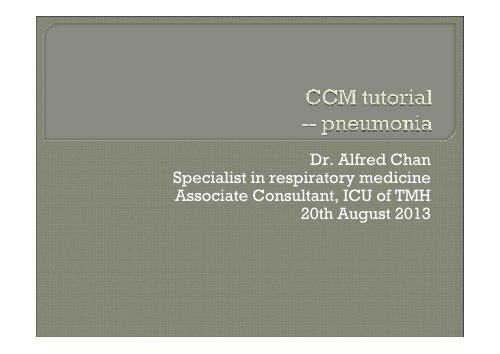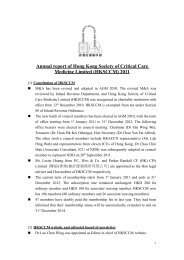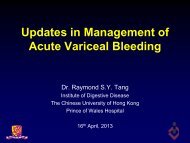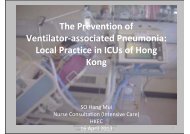Dr. Alfred Chan Specialist in respiratory medicine Associate ...
Dr. Alfred Chan Specialist in respiratory medicine Associate ...
Dr. Alfred Chan Specialist in respiratory medicine Associate ...
- No tags were found...
You also want an ePaper? Increase the reach of your titles
YUMPU automatically turns print PDFs into web optimized ePapers that Google loves.
<strong>Dr</strong>. <strong>Alfred</strong> <strong>Chan</strong><br />
<strong>Specialist</strong> <strong>in</strong> <strong>respiratory</strong> medic<strong>in</strong>e<br />
<strong>Associate</strong> Consultant, ICU of TMH<br />
20th August 2013
Acute <strong>in</strong>fection of the pulmonary<br />
parenchyma that is associated with at<br />
least some symptoms of acute <strong>in</strong>fection,<br />
accompanied by the presence of an<br />
acute <strong>in</strong>filtrate on a chest radiograph,<br />
or auscultatory f<strong>in</strong>d<strong>in</strong>gs consistent with<br />
pneumonia<br />
Bartlett. Cl<strong>in</strong>ical Infect Diseases 2000;31:347-82.
Abnormal <strong>in</strong>flammatory condition of<br />
the lungs as response to noxious stimuli<br />
Typical pneumonia often characterized<br />
as <strong>in</strong>flammation of the parenchyma of<br />
lung (i.e. alveoli) and alveolar fill<strong>in</strong>g with<br />
fluid (consolidation and exudation)<br />
X-ray sign for consolidation: airbronchogram
Air-bronchogram<br />
Typical pneumonia
Interstitial pattern<br />
Ground-glass<br />
Reticular shadow<br />
F<strong>in</strong>e nodules
Fluid or cells<br />
accumulate <strong>in</strong> the<br />
<strong>in</strong>tralobular septum<br />
1. Pulmonary fibrosis<br />
2. Prolonged <strong>in</strong>terstitial<br />
pneumonitis<br />
3. Nodular thicken<strong>in</strong>g:<br />
seen <strong>in</strong> sarcoidosis &<br />
lymphangitis<br />
carc<strong>in</strong>omatosis
Groundglass<br />
Reticular<br />
Consolidation
Typical pneumonia<br />
No age limitation<br />
Purulent sputum<br />
Extra-pulmonary<br />
presentation less<br />
Consolidation<br />
Expansion <strong>in</strong> volume<br />
Pleural effusion +/-<br />
Causes: bacteria<br />
Atypical pneumonia<br />
Affect young adults<br />
Unproductive cough<br />
Hematological,<br />
neurological, GI<br />
Ground-glass<br />
Reticular shadow<br />
Nil pleural effusion<br />
Atypical bacteria,<br />
virus, fungus
Sputum retention<br />
Acute exacerbation of COPD<br />
Pulmonary edema<br />
Pulmonary embolism<br />
Radiation Pneumonitis<br />
Chemical pneumonitis<br />
Inhalational pneumonitis
Millet-like (mean 2 mm; range, 1-5 mm)<br />
seed<strong>in</strong>g of TB bacilli <strong>in</strong> the lung<br />
This pattern is seen <strong>in</strong> 1-3% of all TB<br />
cases<br />
~ 50% of cases are undiagnosed antemortem<br />
20-30% sputum smear +ve<br />
May be associated with cavitat<strong>in</strong>g<br />
primary focus of <strong>in</strong>fection
Diffuse numerous nodules ≤ 3mm, caused<br />
by<br />
1. Miliary TB<br />
2. Viral (VZV)<br />
3. Granulomatous disease<br />
Histoplamosis/ blastomycosis/ cryptoccus<br />
4. Hypersensitivity pneumonitis<br />
5. Metastasis (Thyroid, RCC, Pancreas, Breast,<br />
Melanoma, lymphangitis carc<strong>in</strong>omatosis)<br />
6. Pneumoconiosis
Peribronchi<br />
al cuff<strong>in</strong>g<br />
Fluid <strong>in</strong><br />
fissure<br />
Kerly B<br />
L<strong>in</strong>es
Pre-exist<strong>in</strong>g cardiomegaly (Often)<br />
Stage 1 Pulmonary venous hypertension<br />
Upper lobe pulmonary venous diversion<br />
Ve<strong>in</strong>s diameter > 3mm at the 1 st / 2 nd <strong>in</strong>tercostal space<br />
Stage 2 Interstitial oedema<br />
Kerley B L<strong>in</strong>es (Visible <strong>in</strong>terlobular septa, after be<strong>in</strong>g<br />
filled by fluid, more obvious at basal)<br />
Peribronchial cuff<br />
Stage 3 pulmonary oedema<br />
Fluid accumulates <strong>in</strong> alveolar/ pleural<br />
space
Consistently,<br />
the third<br />
lead<strong>in</strong>g cause<br />
of deaths
CAP<br />
HCA<br />
P<br />
HAP<br />
VAP
The annual <strong>in</strong>cidence rate is 6/1000 <strong>in</strong><br />
the 18-39 age group <strong>in</strong> Brita<strong>in</strong><br />
This rises to 34/1000 <strong>in</strong> people aged 75<br />
years and over<br />
Admission to hospital is needed <strong>in</strong> 20-<br />
40% of patients with CAP<br />
About 5-10% of all hospitalized CAP<br />
patients require ICU admission<br />
The overall CAP mortality is 5-10%<br />
ICU cases mortality 30-60%
Demographics<br />
Age, alcoholism, smok<strong>in</strong>g<br />
Social Factors<br />
Infirmary, old age home<br />
Chronic lung conditions<br />
Asthma/ COPD<br />
Bronchiectasis<br />
Obstructive lesion <strong>in</strong> airways<br />
Immunocompromized state<br />
DM<br />
Chronic steroid<br />
Hyposplenism<br />
Acquired/ congenital immunodeficiency<br />
Therapeutics related<br />
Inhaled corticosteroid<br />
Proton pump <strong>in</strong>hibitor
Bacteria<br />
• Pneumococcus, H <strong>in</strong>fluenzae, Moraxella, Klebsiella,<br />
streptococcus species, CA-MRSA<br />
Virus<br />
• Influenza, para<strong>in</strong>fluenza, adenovirus, RSV, Rh<strong>in</strong>o<br />
Mycobacteria<br />
Fungus<br />
• Candida, Aspergillus, Coccidiomycetes, PCP<br />
Parasite<br />
• Protozoa, Strongyloides<br />
Unclassified<br />
• Chlamydia, mycoplasma, rickettsia
Alcoholism<br />
• Klebsiella, pneumococcus, anaerobic oral flora<br />
COPD and/or Smok<strong>in</strong>g<br />
• Pneumoccus, H. <strong>in</strong>fluenza, Moraxella, Pseudomonas (<strong>in</strong><br />
advanced disease)<br />
Structural lung disease<br />
• GNB, Pseudomonas, Burkholderia, Staphylococcus<br />
Impaired airway protection<br />
• Oral anaerobes, GNB<br />
HIV<br />
• PCP, Pneumococcus, TB, CMV, Candidiasis
49% with 1 , 5.7% with 2, 1.8% with 3<br />
pathogens identified <strong>in</strong> same episode<br />
Pneumococcus 16.9%<br />
Hemophilus 8.9%<br />
Other GNB 9.8%<br />
Flu A + Flu B + ParaFlu 12.2%<br />
Mycoplasma 8.9%<br />
TB 1.1% !!<br />
Yeung, PMH
Triage site of care accord<strong>in</strong>g to severity<br />
Select appropriate case to admit ICU<br />
Cover pathogens accord<strong>in</strong>g to cl<strong>in</strong>ical<br />
profiles and local experience<br />
Organ support for failure<br />
Watch out of drug resistance<br />
Tackle complications promptly<br />
Controversy
http://www.mdcalc.com/psi-port-score-pneumonia-severity-<strong>in</strong>dex-adult-cap/
Class I: all factors NEG<br />
Class II: score < 70<br />
Class III: score 71-90<br />
Class IV: score 91-130<br />
Class V: score >130<br />
0.1% died<br />
0.6% died<br />
2.8% died<br />
8.2% died<br />
29.2% died<br />
30-day mortality<br />
Medisgroup study 1989
CURB variables :<br />
C-Confusion<br />
U-Urea(>7 mmol/L)<br />
R-Respiratory rate (>30)<br />
B-Blood pressure (
Score 0 or 1<br />
• Low risk patients, may treat at OPD<br />
Score 2<br />
• Raised risk of death, consider <strong>in</strong>-patient<br />
• Needs cl<strong>in</strong>ical judgement<br />
Score 3 or more<br />
• Severe pneumonia, need urgent <strong>in</strong>-patient
• Overall performance similar for all three tools<br />
• Best negative likelihood ratio for PSI low-risk group<br />
• CURB-65/ CRB-65 performed best to identify high-risk groups<br />
Thorax 2010; 65: 878-883
1 major or 3 m<strong>in</strong>or criteria for ICU care<br />
Major criteria:<br />
• Invasive mechanical ventilation<br />
• Septic shock <strong>in</strong> need of vasopressor<br />
M<strong>in</strong>or criteria:<br />
• Respiratory rate 30 or above per m<strong>in</strong>ute<br />
• PaO2/ FiO2 ratio 250 or less<br />
• Multi-lobar <strong>in</strong>filtrates on CXR<br />
• New onset confusion/ disorientation<br />
• Hypotension requir<strong>in</strong>g aggressive IVF<br />
• Hypothermia < 36 Celsius<br />
• Thrombocytopenia: Platelet count
Blood cultures<br />
+ve <strong>in</strong> 5-14% of pre-treated patients<br />
Adequate volume and more than one<br />
Gram-sta<strong>in</strong> and cultures<br />
No evidence to favor lower tract specimen <strong>in</strong> terms of<br />
cl<strong>in</strong>ical response and survival<br />
Lower tract sample more likely affect change of A/B<br />
Ur<strong>in</strong>e antigen<br />
Sensitivity limited <strong>in</strong> Legionella and Pneumococcus<br />
Serology/ Molecular<br />
Essentially for atypical pathogens
Rapid antigen test<br />
Immuno-florescence test<br />
Polymerase Cha<strong>in</strong> Reaction (PCR)<br />
method to detect genetic material<br />
Reverse transcriptase (RT-PCR) for RNA virus<br />
Direct PCR for DNA virus<br />
Mycoplasma<br />
Mycobacterial TB<br />
Chlamydia<br />
Flu/ ParaFlu/ Adeno/ RSV/ Metapneumo/ Rh<strong>in</strong>o
Bronchoscopic<br />
• BAL<br />
• PSB<br />
Non-bronchoscopic<br />
• Tracheobronchial aspiration<br />
• M<strong>in</strong>i-BAL<br />
Bronchoscopic sampl<strong>in</strong>g does not improve<br />
mortality, length of hospital stay, duration of<br />
MV or length of ICU stay. However, it may lead<br />
to a narrower antimicrobial regimen and/or<br />
more rapid de-escalation of antimicrobial<br />
therapy
A fiberoptic bronchoscope is directed to<br />
the area of concern with<strong>in</strong> the lung,<br />
which is flushed with sterile fluid.<br />
Quantitative cultures are usually<br />
obta<strong>in</strong>ed<br />
The large volume of the specimen makes<br />
it useful for detect<strong>in</strong>g nonbacterial<br />
pathogens.<br />
Sensitivity ranges from 42-93%<br />
Specificity 45-100%
Specialized catheter conta<strong>in</strong><strong>in</strong>g a brush<br />
When the area to be sampled is<br />
visualized <strong>in</strong> FOB, the brush is pushed<br />
through a plug and a sample obta<strong>in</strong>ed by<br />
gentle scrap<strong>in</strong>g.<br />
Sample is low volume, it is not<br />
appropriate for detection of nonbacterial<br />
pathogens.
Non-Bronchoscopic BAL<br />
Telescop<strong>in</strong>g catheter system protects the<br />
end of the catheter from contam<strong>in</strong>ation<br />
dur<strong>in</strong>g <strong>in</strong>sertion. The catheter is advanced<br />
approximately 30 cm and the <strong>in</strong>ner cannula<br />
is then gently advanced until it meets<br />
resistance. Thirty mL of sterile sal<strong>in</strong>e is<br />
<strong>in</strong>jected and suctioned.<br />
Usually the lower lobe is sampled<br />
Bleed<strong>in</strong>g is a potential complication
Different Thresholds for different sampl<strong>in</strong>g methods<br />
• 10 6 cfu/ml: tracheobronchial aspiration<br />
• 10 4 cfu/ml: BAL<br />
• 10 3 cfu/nl: PSB<br />
Quantitative cultures derived from nonbronchoscopic<br />
specimens tend to have a lower specificity than those<br />
derived from bronchoscopic specimens<br />
However, this is balanced by a higher sensitivity,<br />
result<strong>in</strong>g <strong>in</strong> comparable diagnostic accuracy<br />
Quantitative cultures do not appear to improve cl<strong>in</strong>ical<br />
outcomes. They may lead to more judicious use of<br />
antibiotics
Not use rout<strong>in</strong>ely to guide the decision of<br />
whether to <strong>in</strong>itiate antibiotics <strong>in</strong> patients<br />
with suspected VAP<br />
May be helpful <strong>in</strong> the decision as to<br />
whether to discont<strong>in</strong>ue antibiotic therapy<br />
Progressive <strong>in</strong>creases <strong>in</strong> serum<br />
procalciton<strong>in</strong> have been associated with<br />
septic shock and mortality
Surviv<strong>in</strong>g sepsis campaign
Goal-directed resuscitation should beg<strong>in</strong> immediately upon<br />
recognition of the syndrome and target:<br />
• CVP 8-12mmHg<br />
• MAP >65mmHg<br />
• Ur<strong>in</strong>e Output >0.5ml/kg/hour<br />
• Central Venous Oxygen Saturation >70%<br />
With<strong>in</strong> first 6 hours, if SaCV is less than 70%, RBC<br />
transfusion or dobutam<strong>in</strong>e <strong>in</strong>fusion should be employed<br />
Either norep<strong>in</strong>ephr<strong>in</strong>e or adrenal<strong>in</strong>e as vasopressor agents
Crystalloid or colloid solutions are equally<br />
effective <strong>in</strong> resuscitation<br />
Appropriate cultures immediately<br />
Antibiotics should be given with<strong>in</strong> first hour,<br />
but after cultures be<strong>in</strong>g obta<strong>in</strong>ed. De-escalate<br />
as appropriate<br />
Low-dose steroids if patients still need<br />
vasopressors after adequate IVF resuscitation<br />
Sedation with protocol and daily <strong>in</strong>terruption<br />
Nutrition/ glycemic control
Pr<strong>in</strong>ciples:<br />
As early as possible<br />
As broad as possible<br />
In light of local prevalence study<br />
Adequate workup<br />
As short as <strong>in</strong>dicated (7-10days)<br />
De-escalation based on microbiology<br />
result and cl<strong>in</strong>ical response
Increas<strong>in</strong>g resistance rate of<br />
Mycoplasma to Macrolide<br />
Dom<strong>in</strong>ant resistant stra<strong>in</strong> of<br />
pneumococcus to <strong>respiratory</strong> qu<strong>in</strong>olones<br />
Severe CAP lead<strong>in</strong>g to ICU admission<br />
coverage of Enterobacteriacea<br />
<strong>in</strong>creas<strong>in</strong>g ESBL producer<br />
CA-MRSA
76% community<br />
isolates of<br />
Mycoplasma are<br />
resistant to<br />
macrolides<br />
Ho et al, 2013
Coverage for CA-MRSA should be considered.<br />
• Non-Ch<strong>in</strong>ese ethnicity (e.g. Filip<strong>in</strong>os, Caucasian)<br />
• Patients with concurrent sk<strong>in</strong> <strong>in</strong>fection (e.g. abscess)<br />
• Patients with known exposure to CA-MRSA<br />
• Patients with chest X-ray suggestive of staphylococcal <strong>in</strong>fection<br />
(e.g. cavitatory, peumatoceles)<br />
• Patients whose pleural fluid or brochial aspirate lavage show<br />
clusters of gram positive cocci<br />
• Patients presented with haemoptysis<br />
Intravenous l<strong>in</strong>ezolid is preferred and vancomyc<strong>in</strong> is<br />
the alternative.
IMPACT 4 th Edition, Hong Kong
Sputum retention<br />
Respiratory Failure/ ARDS<br />
Septic shock<br />
Multi-organ failure with DIC<br />
Metastatic <strong>in</strong>fection<br />
Lung Abscess<br />
Complicated parapneumonic pleural<br />
effusion/ empyema<br />
Pneumothorax
Host factors<br />
• Age extreme<br />
• Immunocompromized<br />
• Malnourished<br />
• Diseased lungs<br />
Disease factors<br />
• Severity: bacteremic, multi-lobar<br />
• Pathogens: pneumoccocus, pseudomonas, ac<strong>in</strong>etobacter<br />
• Non-<strong>in</strong>fectious conditions<br />
Treatment factors<br />
• Late antibiotics<br />
• Inadequate dos<strong>in</strong>g<br />
• Resistance/ tolerance
F<strong>in</strong>d<strong>in</strong>gs from 24 trials (5015 patients)<br />
• Mortality: atypical vs. typical (RR 1.13; 95% 1.54)<br />
• Atypical arm:<br />
Insignificant trend towards cl<strong>in</strong>ical success<br />
Significant bacterial eradication most notably for Legionella<br />
Not significant for Pneumococcus<br />
Conclusions<br />
No survival or cl<strong>in</strong>ical efficacy benefit to empirical<br />
atypical coverage <strong>in</strong> hospitalised CAP patients<br />
Cochrane Library<br />
2005
By penicill<strong>in</strong> susceptibility<br />
Variable<br />
All patients<br />
(n = 638)<br />
Sensitive<br />
(n = 409)<br />
Intermediate<br />
(n = 164)<br />
Resistant<br />
(n = 65)<br />
P<br />
Total mortality 14.4 12.2 18.3 18.5 .054<br />
Mechanical ventilation 13 12 16.5 10.8 .673<br />
Shock 16 15.4 17.1 16.9 .666<br />
DIC 2 2.9 0.6 0 .038<br />
Empyema 8.3 10 4.9 6.2 .041<br />
Bacteremia 73.6 77.4 61.1 72.9 .022<br />
Aspa J et al, Cl<strong>in</strong> Infect Dis 2004
For severe pneumococcal CAP<br />
always measure MIC <strong>in</strong> isolates<br />
cut-off MIC to decide resistance<br />
Susceptible: < 1 mcg/ml<br />
Intermediate: >1 but < 2 mcg/ml<br />
Resistance: >4 mcg/ml<br />
Need validation <strong>in</strong> large-scale<br />
prospective trials<br />
Not for other sites
30-year-old woman<br />
2-day history of fever, cough and dyspnea. She<br />
had a recent URTI characterized by fever, sore<br />
throat, myalgias and arthralgias<br />
In distress with a pulse of 120/m<strong>in</strong>, <strong>respiratory</strong><br />
rate 38/m<strong>in</strong>, blood pressure 95/60 mmHg, and<br />
temperature 39.0 0 C.<br />
Oxygen saturation was 75% with the patient<br />
breath<strong>in</strong>g room air.
Her CXR showed bilateral lung air-space<br />
consolidation.<br />
She was immediately <strong>in</strong>tubated and<br />
transferred to the ICU<br />
Required high FiO 2 and 12 cm H 2 O of<br />
PEEP to ma<strong>in</strong>ta<strong>in</strong> acceptable<br />
oxygenation.<br />
What is your plan of management
Nursed <strong>in</strong> isolation room with NEG pressure<br />
Arrange appropriate sampl<strong>in</strong>g<br />
(Nasopharyngeal aspirate or bronchial aspirate)<br />
for RT-PCR and viral culture.<br />
Commence Tamiflu prior to results.<br />
Empirical antibiotics for typical and atypical<br />
pneumonia are to be given.
NPA for RT-PCR for <strong>in</strong>flenza A (H1N1)<br />
was positive<br />
What treatment would you give to this<br />
patient
Oseltamivir (Tamiflu), Zanamivir (Relenza)<br />
Both are neuram<strong>in</strong>idase <strong>in</strong>hibitors<br />
Both have activity aga<strong>in</strong>st <strong>in</strong>fluenza A and B<br />
Oseltamivir is adm<strong>in</strong>istered orally<br />
Zanamivir has been given iv and <strong>in</strong>tranasally<br />
via a Diskhaler<br />
Zanamivir for nebulization have not been<br />
approved by the FDA.<br />
Relenza Inhalation Powder should only be used<br />
by us<strong>in</strong>g the Diskhaler device provided.
Gram sta<strong>in</strong> of tracheal secretion <strong>in</strong>dicated Grampositive<br />
cocci <strong>in</strong> clusters<br />
The patient was started on l<strong>in</strong>ezolid<br />
On the third hospital day she developed tachycardia<br />
and hypotension not responsive to fluid replacement.<br />
There were worsen<strong>in</strong>g <strong>in</strong> hypotension and hypoxemia<br />
Serial CXRs...............
CXR compatible with ARDS<br />
Her antibiotic were cont<strong>in</strong>ued,<br />
norep<strong>in</strong>ephr<strong>in</strong>e and vasopress<strong>in</strong> were<br />
started, and she was treated<br />
aggressively for sepsis.<br />
She developed renal <strong>in</strong>sufficiency and<br />
metabolic acidosis.
Na 142<br />
K 4.1<br />
Cl 105<br />
HCO 3 6<br />
Creat<strong>in</strong><strong>in</strong>e 168<br />
ABG<br />
• pH 7.24<br />
• PO 2 96mmHg (12.8kPa)<br />
• PCO 2 14 mmHg (1.8 kPa)<br />
What is the most likely cause of the metabolic<br />
disorder <strong>in</strong> this patient
High anion-gap metabolic acidosis.<br />
Causes of acidosis:<br />
• Sepsis/ septic shock <strong>in</strong>duced lactic acidosis<br />
• Renal failure<br />
• <strong>Dr</strong>ugs: L<strong>in</strong>ezolid
52-year-old eng<strong>in</strong>eer visited GP for URTI symptoms<br />
He was found dur<strong>in</strong>g the <strong>in</strong>take process to have<br />
oxygen saturation <strong>in</strong> the mid-80% range.<br />
He was referred to the A&E Department, where he was<br />
found to be hypotensive, with a systolic blood pressure<br />
of 85 mmHg and an oxygen saturation of 96% on 2<br />
L/m<strong>in</strong> oxygen via nasal cannula.<br />
<br />
A portable CXR performed<br />
He was admitted for further work-up.
In medical ward he was requir<strong>in</strong>g 100% oxygen via NRM to<br />
ma<strong>in</strong>ta<strong>in</strong> his oxygen saturation <strong>in</strong> the upper 90% range.<br />
He also noted an un<strong>in</strong>tentional 50-pound weight loss over a 2-<br />
month period, low-grade fevers and a 2-3 week of dry cough<br />
<br />
<br />
<br />
<br />
<br />
Known hypertension and bipolar disorder.<br />
His medications <strong>in</strong>cluded paroxet<strong>in</strong>e, hydroxyz<strong>in</strong>e and felodip<strong>in</strong>e.<br />
He was a lifelong nonsmoker and denied any history of alcohol or<br />
<strong>in</strong>travenous drug use.<br />
He was married and liv<strong>in</strong>g with his wife.<br />
His travel and environmental and occupational exposure histories<br />
were unremarkable.
Vital signs<br />
• Temperature 35.4 0 C<br />
• BP 90/59 , HR 70<br />
• RR 22<br />
• SpO2 100% with 100% nonrebreather mask<br />
Appeared chronically ill, mildly<br />
tachpneic<br />
Lung – crackles halfway up both lungs<br />
Heart - NAD
WBC 4.4 x 10 9 /L<br />
• N 3.65 L 0.48<br />
ESR 90<br />
Na 146; K 4.5<br />
Cl 110<br />
HCO3 23<br />
Urea 17.5<br />
Creat 254<br />
LDH 523<br />
Alb 24; Globul<strong>in</strong> 43<br />
ABG:<br />
• pH 7.36<br />
• PaCO2 35mmHg(4.6kPa)<br />
• PaO2 50mmHg(6.6 kPa)<br />
• HCO3 20<br />
Ur<strong>in</strong>e:<br />
• prote<strong>in</strong> 1+<br />
• RBC 3-8
The patient was started on empirical<br />
antibiotic coverage (ceftriaxone and<br />
azithromyc<strong>in</strong>) for community-acquired<br />
pneumonia.<br />
Bronchoscopy was performed<br />
He was <strong>in</strong>tubated for the procedure<br />
Follow<strong>in</strong>g the bronchoscopy, how<br />
would you manage this patient
Empirical<br />
trimethoprim/sulfamethoxazole and oral<br />
prednisone for P. jiroveci pneumonia.<br />
Test<strong>in</strong>g for HIV status
Several days later, his HIV ELISA was<br />
reported as positive. This was<br />
subsequently confirmed with western<br />
blot analysis.<br />
His absolute CD4+ count was 5 cells/ml<br />
and his HIV RNA was >1,000,000<br />
copies/ml.
He received parenteral treatment with<br />
cotrimoxazole and methylprednisolone.<br />
2 weeks later, a sk<strong>in</strong> rash developed<br />
over his body and was itchy.<br />
What was the most likely cause for the<br />
sk<strong>in</strong> rash and what was your<br />
management
For mild to moderate disease, acceptable<br />
alternative regimens <strong>in</strong>clude pentamid<strong>in</strong>e,<br />
atovaquone, dapsone-trimethiprim, or<br />
cl<strong>in</strong>damyc<strong>in</strong>-primaqu<strong>in</strong>e for a similar duration.<br />
For severe pneumonia and a reported drug<br />
allergy to sulfa, desensitization is often<br />
proposed, given the marked benefit of<br />
trimethoprim/sulfamethoxazole <strong>in</strong> severe P.<br />
jiroveci pneumonia.
Cotrimoxazole was stopped and replaced by<br />
pentamid<strong>in</strong>e.<br />
His cl<strong>in</strong>ical and radiologic condition<br />
normalized<br />
HAART was started subsequently<br />
What precautions and monitor<strong>in</strong>g should be<br />
taken for patients on pentamid<strong>in</strong>e therapy
Hypoglycemia<br />
Hypotension (the drug should be given while<br />
the patient is sup<strong>in</strong>e, adequately hydrated, and<br />
adm<strong>in</strong>istered over at least 60 m<strong>in</strong>utes)<br />
Renal function and glucose, calcium, and<br />
electrolyte concentrations should be<br />
monitored<br />
Periodic monitor<strong>in</strong>g of complete blood counts<br />
and liver function tests is also recommended.
Antiretroviral therapy <strong>in</strong> the ICU
Defer ART until the acute <strong>respiratory</strong> illness<br />
has been treated <strong>in</strong> patients not already<br />
receiv<strong>in</strong>g ART (particularly <strong>in</strong> patients for<br />
whom PCP leads to the diagnosis of HIV<br />
<strong>in</strong>fection)<br />
ART start times should therefore vary<br />
depend<strong>in</strong>g on the patient’s <strong>in</strong>dividual cl<strong>in</strong>ical<br />
course, tolerance of the anti-PCP regimen
In patients not on ART, ART should be<br />
<strong>in</strong>itiated, when possible, with<strong>in</strong> 2 weeks<br />
of diagnosis of PCP<br />
In a RCT of 282 patients with <strong>in</strong>fections<br />
other than TB, (63% of whom had PCP), a<br />
significantly lower <strong>in</strong>cidence of AIDS<br />
progression/ death by early HAART (12<br />
days vs. 45 days)
Bilateral pneumothorax and<br />
pneumomediast<strong>in</strong>um, with bilateral chest<br />
dra<strong>in</strong>s <strong>in</strong>serted<br />
3 weeks later, the lungs were fully<br />
expanded but air leak persisted<br />
What are the strategies for ventilat<strong>in</strong>g a<br />
patient with significant air leak
M<strong>in</strong>imiz<strong>in</strong>g peak airway pressure <strong>in</strong> BPF and<br />
transpulmonary pressure (alveolar pressure –<br />
<strong>in</strong>trapleural pressue) <strong>in</strong> APF<br />
Lowest effective TV, m<strong>in</strong>imal PEEP, least no of<br />
positive-pressure breaths<br />
Any negative suction through chest dra<strong>in</strong><br />
should be discont<strong>in</strong>ued as early as possible<br />
Look out for hyperventilation due to autotrigger<strong>in</strong>g
APF (Alveolo-pleural fistula)<br />
• Communication between the pulmonary<br />
parenchyma distal to a segmental bronchus and<br />
the pleural space<br />
BPF (Broncho-pleural fistula)<br />
• Communication between the lobar or segmental<br />
bronchi and the pleural space
Aetiology<br />
Pathophysiology<br />
•Postoperative<br />
BPF<br />
•Blunt or penetrat<strong>in</strong>g trauma<br />
•Airway laceration follow<strong>in</strong>g<br />
<strong>in</strong>tubation<br />
•Gas shunted through a<br />
proximal fistula has not<br />
participated <strong>in</strong> gaseous<br />
exchange<br />
•Alveolar hypoventilation<br />
significant<br />
APF<br />
•Necrotiz<strong>in</strong>g <strong>in</strong>fection<br />
•Iatragenic laceration of visceral<br />
pleura<br />
•Barotrauma from MV<br />
•Traumatic laceration of visceral<br />
pleural<br />
•Persisent spontaneous<br />
pneumothorax<br />
•Invasive tumor, chemotherapy<br />
and irradiation<br />
•Gas shunted through a<br />
peripheral fistula participates <strong>in</strong><br />
gaseous exchange to some<br />
extent<br />
•Alveolar hypoventilation usually<br />
not significantly compromised
Repair is necessary when air leak persist<br />
for more than 7-14 days to avoid<br />
• <strong>in</strong>fective complications<br />
• complications associated with prolonged<br />
immobilization<br />
• ventilatory failure.
Surgical repair<br />
• VAT<br />
• thoracotomy<br />
Chemical pleurodesis<br />
Endoscopic closure<br />
• Sealants <strong>in</strong>jection<br />
• Devices placement eg endobrochial watanabe<br />
spigot, endobronchial valves, Amplatzer device
1. Keep the head of the patient’s bed up to at least 30 0<br />
unless contra<strong>in</strong>dicated<br />
2. Use antiseptic oral r<strong>in</strong>se to provide oral care to<br />
patients with ETT on regular basis<br />
3. Perform hand hygiene before and after each<br />
<strong>respiratory</strong> care<br />
4. Review sedation at least daily<br />
5. Assess patient’s read<strong>in</strong>ess to wean or to extubate at<br />
least daily<br />
6. Prevent condensate from enter<strong>in</strong>g patient’s airway<br />
7. Ma<strong>in</strong>ta<strong>in</strong> proper care of the <strong>respiratory</strong> consumables<br />
and equipments<br />
8. Conduct ongo<strong>in</strong>g active VAP surveillance






